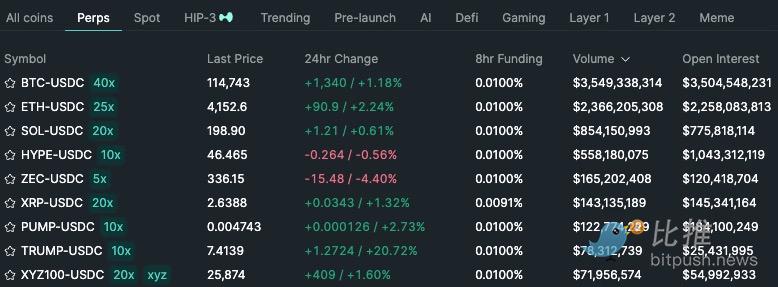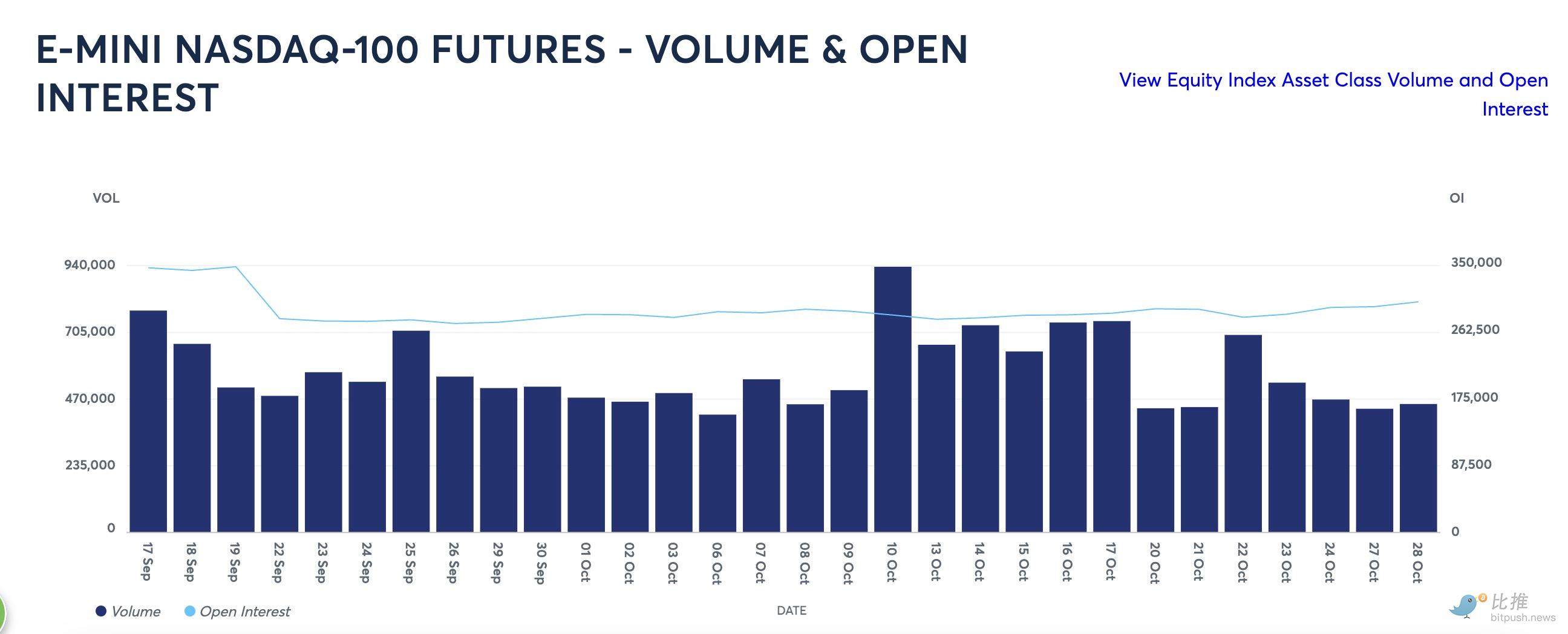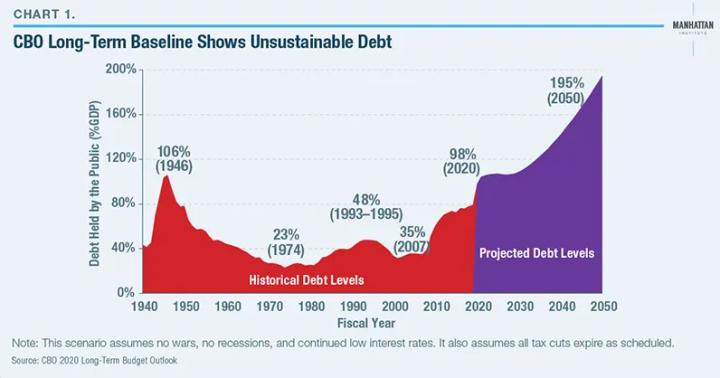" On-chain US stocks " is not a new concept, but given the recent consolidation in the crypto market and the lack of clear direction for mainstream coins, this sector remains a hot trading ground.
Over the past year, many projects in the market have attempted to bring US stock indices , Treasury yields, and even individual stocks onto the blockchain. However, most of these products remain at the "shadow asset" stage: either their prices rely too heavily on oracles, their trading depth is insufficient, or there is still a significant price difference with the traditional market, making it difficult to be regarded as a truly "alternative market".
Hyperliquid 's HIP-3 upgrade appears to be a turning point. This upgrade technically allows permissionless creation of perpetual markets with native on-chain order books. This, to some extent, ends the situation where traditional on-chain asset trading mainly relies on synthetic assets or oracle-driven models, providing another possibility for building an independent market on-chain with self-discovery capabilities.
Take TradeXYZ's XYZ100 as an example: since its launch, its trading volume has continued to climb, with daily turnover stabilizing at tens of millions of US dollars, and the upper limit of open interest increasing from the initial $25 million to $60 million.

background
TradeXYZ, a native protocol incubated on Hyperliquid within the Unit ecosystem, focuses on bringing real-world assets (RWAs)—such as US stocks and indices—to on-chain trading scenarios through tokenization. The protocol supports both spot and perpetual contract trading modes and handles spot asset liquidity and settlement through integration with the Unit Protocol. Users can deposit, withdraw, and trade using USDC. Its core product is currently an equity-based perpetual contract built on the HIP-3 standard, aiming to bridge the gap between traditional financial markets and decentralized trading experiences.
XYZ100 is a fully on-chain CLOB (Central Limit Order Book) model that supports up to 20x leverage and 24/7 trading. The price is anchored to the Nasdaq futures oracle on the CME (Chicago Mercantile Exchange), and an 8-hour EMA (Exponential Moving Average) is used to smooth the price during non-trading hours to avoid drastic fluctuations.
HIP-3 was officially launched around October 13, 2025. TradeXYZ launched XYZ100 almost simultaneously, with alpha access limited to the first 100 whitelisted users (who must have accumulated trading volume of more than $5 million on Hyperliquid).
In just two days, the trading volume of XYZ100 exceeded $63 million, and OI reached $15 million, far surpassing other RWA perpetual contract DEXs.
Why are crypto traders turning to US stocks?
First, the “high volatility and low certainty” of crypto is being crushed by the “steady growth” of US stocks: Although there are signs of institutional accumulation in BTC, the “leveraged crash” on October 11 has left retail investors with lingering fears.
Meanwhile, the US stock market is currently experiencing a surge, with the S&P 500, Dow Jones, and Nasdaq indices hitting record highs for three consecutive trading days this week. At the same time, on-chain trading platforms are attracting global investors with their unique advantages: 24/7 uninterrupted trading, no KYC verification required, and leverage up to 20x, allowing users from different time zones in Asia and Europe to adjust their positions at any time, completely eliminating the limitations of traditional market T+1 settlement mechanisms and weekend closures.
However, the daily trading volume of traditional Nasdaq E-mini futures on the CME is still as high as hundreds of billions of dollars, while the scale of on-chain assets is still a "decimal number" in comparison.
Competition in the on-chain US stock market
With the rise of this trend, the entire on-chain US stock market ecosystem is evolving rapidly, with multiple protocols entering the market from different angles:
On Solana and BNB Chain, xStocks offers spot trading of over 80 US stocks/ETFs through its alliance ecosystem, allowing users to directly collateralize loans using Apple or Tesla tokens. The protocol has accumulated over $2 billion in trading volume, representing 58.4% of tokenized stock trading volume in 2025, with over 30,000 daily active users, and is gradually taking away Robinhood's retail market share.
Derive.xyz focuses on multi-chain options and perpetual contracts, covering Bitcoin, Ethereum, and some RWA indices, attracting advanced users with its institutional-grade tools and real-time oracles. Although fees are high and the learning curve is steep, total trading volume has reached $18.6 billion, with the RWA perpetual submarket maintaining an average monthly trading volume of $500 million.
Kraken xStocks, backed by an exchange, has received preliminary approval from the SEC and is migrating to second-layer networks like Arbitrum to improve composability. Its cumulative trading volume has surpassed $5 billion, with over 37,000 unique holders covering more than 60 assets; however, its non-full on-chain custody model still carries centralized risks.
Vest Markets has taken a different approach, focusing on reducing slippage during weekend trading through an RFQ filling mechanism, achieving a 24-hour trading volume of $34.05 million. While its blockchain auditing and LP incentive models are innovative, current market depth remains insufficient.
Ostium , based on Arbitrum, offers a full-chain experience for synthetic RWA perpetual contracts, expanding from US stocks to commodities such as crude oil and gold. The protocol's TVL growth rate exceeds 150%, and its Q1 perpetual contract trading volume reached $2.36 billion, providing an important option for users with no KYC experience.
Risks and Challenges
Of course, all of this is not without controversy.
Ostium Labs co-founder Kaledora points out that the model of rebuilding market depth using on-chain order books is more suitable for crypto-native assets than for traditional financial assets, because the latter have a more stable, centralized, and deeper liquidity structure. In Kaledora's view, a better solution is the "on-chain brokerage model": directly referencing the price depth of the TradeFi market and accessing it through on-chain channels, rather than attempting to rebuild an order book on-chain to compete with CME.
Another risk is oracle and manipulation. During non-trading hours, on-chain prices rely on algorithms to smooth price movements, but this is not foolproof. Previously, PAXG gold contracts experienced the liquidation of millions of dollars in positions due to abnormal price fluctuations, which served as a warning to all RWA products—the risk of price deviations does exist when the market is closed but on-chain trading continues.
Regulatory uncertainty is also a major concern. The U.S. Securities and Exchange Commission (SEC) is reviewing the compliance of these on-chain U.S. stock products, and if they are ultimately classified as securities, existing DeFi protocols may need to apply for the corresponding licenses. While many projects are exploring compliance paths, most are still operating in a regulatory gray area.
summary
The crypto world once entertained itself within its own circles: new chains, new coins, new stories, new narratives. But true financial power comes from who can support the markets that global capital truly wants to participate in.
Nasdaq has always been there, trillions of dollars have flowed there, and the world's most valuable companies have been traded there.
Therefore, true crypto players don't care where the battlefield is, they only care where the opportunities lie.
Author: seedly.eth
Twitter: https://twitter.com/BitpushNewsCN
BitPush TG discussion group: https://t.me/BitPushCommunity
Bitpush TG subscription: https://t.me/bitpush









